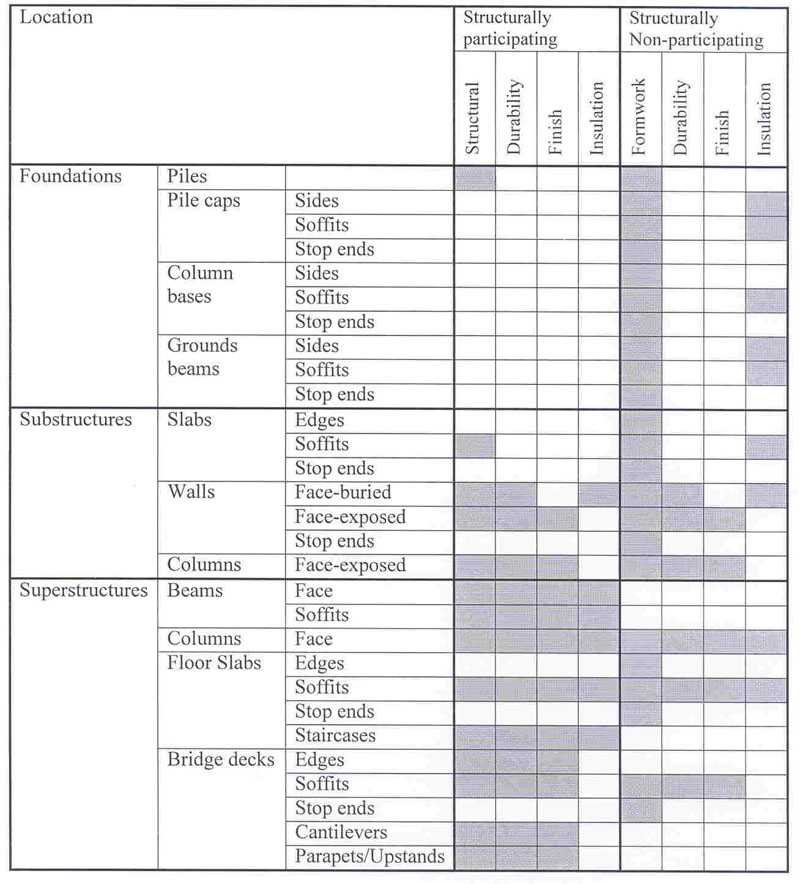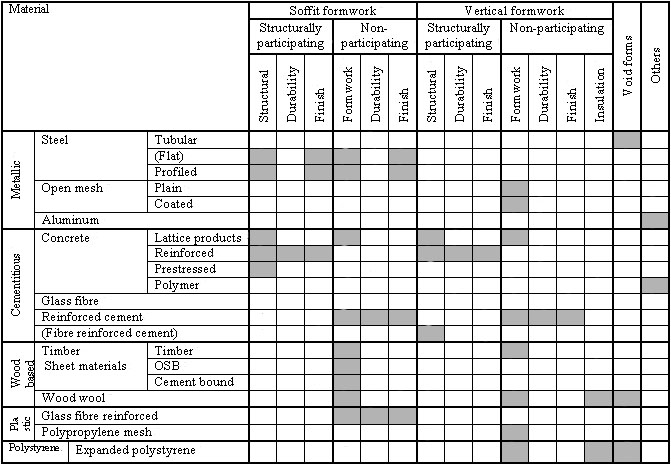Formwork
|
| |||||||||||||||||||||||||||||||||||||||||||||||||||||||||||||||||||||||||||||||||||||||||||||||||||||||||||||||||||||||||||||||||||||||||||||||||||||||||||||||||||||||||||||||||||||||||||||||||||||||||||||||||||||||||||||||||||||||||||||||||
|
Large panel formwork consists mainly of large pieces of metal formwork. It is most suitable for construction activities where formwork is highly repetitive as it can be reused many times. Therefore, its design is specified for the construction of the load bearing walls of typical floors in high rise tower blocks. |
|
Compared with traditional timber formwork, metal panel formwork has several advantages. The use of large panel formwork can save time and labour in erecting, striking and re-erecting the formwork as the panel is handled as one unit. It can also produce a concrete surface, which is neater than is produced normally by conventional timber formwork, and the surface essentially needs no additional applied finishes for levelling. On site waste audit records also show large panel formwork systems are effective in reducing concrete waste generated by losses due to damaged formwork, which usually accounts for 30% of the total concrete waste. However, because of the weight of large panel formwork, tower cranes should be available for its handling. |
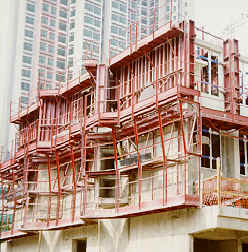
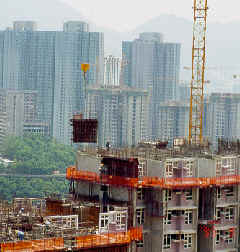
Large panel formwork
Removal of formwork
|
Different large panel formwork systems are widely used today by contractors for constructing standardised housing blocks, and are broadly classified as wall forms, table forms and tunnel forms. |
| Wall Forms |
|
The wall forms are combined with the slab form so that the wall and slabs can be formed monolithically in one casting operation, and the number of joints between panels is minimised. There is less chance of grout leakage or an uneven surface finish at the joint, which is a common fault with in traditional timber formwork. |
| Table Forms |
|
Standard modules of housing blocks are relatively large in span and large table forms are widely used for assembly time reduction, fewer joints and better surface finishes. The table method uses separate vertical forms for walls and horizontal table forms for floor slabs. The work is done in two stages. First, the walls are cast, and forms are stripped, the tables are then positioned, and the horizontal slabs are cast. |
| Tunnel Forms |
|
The half tunnel is composed of vertical and horizontal panels set at right angles and supported by struts and props. The walls and slabs are cast in a single operation. Like the wall-forms and table forms, this reduces not only the number of joints, but also the assembly time. Therefore, the casting of walls and slabs can be completed in the one day. |
Because steel forms are very durable, one set of steel forms can be used to complete a project, and then reused for another project or scrapped for recycling. Steel forms can produce a better quality concrete finish when compared with timber forms. Although their initial cost is higher, they can be cheaper in the long run, particularly with their recycling potential.
|
Steel decking, becoming a permanent part of a composite slab, serves as both the working platform and formwork for supporting the in-situ slab concrete in the construction stage. The steel of the decking can also utilised to provide some of the required permanent reinforcement for the slab. In other words, the decking can replace both timber formwork and bottom reinforcement, reducing the amount of temporary works and formwork required. |
|
Aluminum formwork consists of small aluminum framed panels which are easy for handling. It is fast to erect and strike and the floor cycle can be 4 days. It is durable and can be reused over 100 times. Although it is more expensive than steel and timber, its merit is its lightweight and recycling potential. |
|
PVC and polyurethane forms can be used to replace timber forms in either rigid or flexible formats. Special floor forms made of fibreglass are occasionally used (6%). They can be reused over 50 times and produce a concrete surface finish similar in appearance to fine snake skin. If a smooth finish is desired, a paste wax or water-based release agent can be applied to the form. |
| Rib Loc Circular Column |
|
This UPVC form is usually used to cast circular columns of diameter ranging from 150 to 3000mm. It is made by spirally winding a ribbed plastic profile into a tube. This enables column forms to be constructed which are strong, lightweight, easy to strip and which provide an excellent surface finish. The surface also incorporates the inherent “waxiness” of extruded plastic and no form oil is required. Square stabilisation timbers are fixed at the foot of the column formwork to stop the formwork moving out of position. Vertical bracing timbers are placed against possible movement while concreting. The process is cost efficient with recycling potential. |
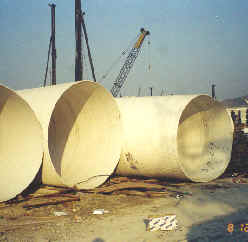
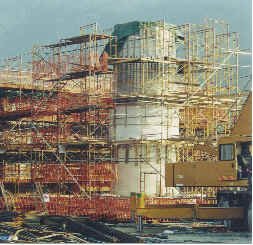
UPVC column forms
Erection of column forms
| Pecaform |
|
This is made by laminating a layer of polyethylene to each side of a high tensile steel wire mesh. This combination creates a material that is both light and structurally strong, making it very easy to handle. It can be used for constructing ground beams, pile caps, footings, curved structures, ribbed and waffle slabs. The formwork is cut-to-size and bent to shape at factory and arrives at site ready for installation. There is no need to strip formwork after the concrete has cured. No waste is produced. A clean and neat site can be obtained in the foundation stage with Pecaform. |
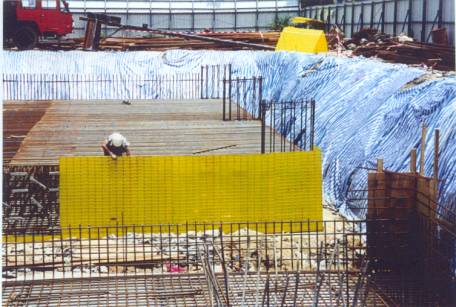
Construction of pile caps using Pecaform
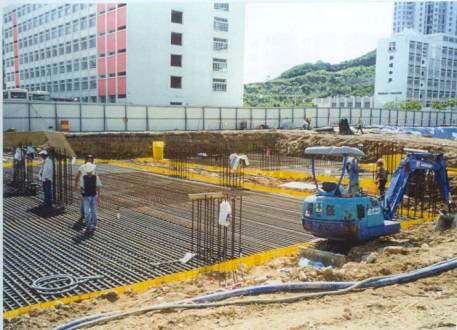
Backfill around pile caps about 150mm from the top level of Pecaform
|
The coating of conventional plywood with a thick layer of polymer resin may improve the quality and durability of the formwork. For example, applying a medium density overlay or a high density overlay on plywood can increase the number of reuses to 20. The form can be easily dismantled and handled by small cranes and can be adjusted to suit architectural requirements. |
|
|
VSL Hong Kong Limited |
| 3/F
Stelux House, 698 Prince Edward Road East, San Po Kong, Kowloon, Hong Kong. |
|
| Tel: (852) 2590 2288 | |
| Fax: (852) 2590 0290 |
|
|
Proposed
Residential Development at 5-7 Blue Pool Road, Happy Valley,
Hong Kong |
|
|
Tung Chung Station Development Package One, Site 3, Hong Kong |
